Research methods
1/85
Earn XP
Description and Tags
Paper 2
Name | Mastery | Learn | Test | Matching | Spaced |
|---|
No study sessions yet.
86 Terms
Investigator effect
conscious or unconscious effect of the investigator on the dependent variable e.g. through leading questions, interactions like frowning or nodding
using double negative questions, self report
hard to decipher e.g. are you not unhappy in your job
correlations
shows strength and association between 2 co-variables
presented on a scattergram using quantitative data
correlation coefficient- shows how strong a correlation is
+ correlation= + value (closer to 1, stronger +)
- correlation = - value (closer to -1, stronger -)
no correlation = 0
correlation hypothesis
directional + or -
non-directional: is a correlation
null= none
E.G. There is … correlation between… and …
act of starting point by producing precise quantifiable measure of how co-variables are related- further research and experiments can find causation
using secondary data makes research less time consuming as do not have to gather data
does no explain why so can’t infer cause and effect
cannot explain curvilinear relationships e.g. yerkes dodson law more complex than ±
may be 3rd variable that causes relationship e.g. balding and long marriage → age
using double barelled questioms
hard to answer as 2 questio
pilot study
small scale trial run in investigation before real thing is conducted
saves time and money
check procedures and technologies work
make changes and modifications as necessary
generalisation
extent to which findings can be broadly applied to population
extraneous variable
aspect that is not the independent variable but can affect dependent variable when not controlled but can be controlled easily e.g. the age of the participants
primary data and evaluation
original data collected for the purpose of investigation
authentic data obtained specifically so targets information required
requires time and effort from the researchers to produce
secondary data and evaluation
collected by someone other than the researcher prior to research
inexpensive and easily accessed so requires minimal effort
variation in quality and accuracy of secondary data, may be outdated or incomplete
content of data may not match researcher’s needs or objectives so challenges validity of conclusions
quantitative data and evaluation
expressed numerically
easy to analyse so comparisons and patterns can be easily idenfitied
data less open to bias
narrower in meaning and detail so may fail to represent daily life
qualitative data and evaluation
expressed in words
rich detailed data
chance to fully report thoughts, feelings and opinion on a given subject
often has higher external validity so gives meaningful insight into participants worldview
harder to analyse as cannot be summarised statistically so patterns in data harder to identify
conclusions rely on subjective interpretations of the researcher which could be subject to bias
leading questions
guides respondent to particular answers
behavioural categories (observations) and evaluation
breaking down target behaviour to smaller components
data collection more structured and objective so recording of data is more systematic meaning it is easier to analyse and improve data
difficult to include all possible forms of target behaviour, there should not be an ‘other’ category where many behaviours are deposited despite not being similar.
standard deviation, measure of dispersion
how far scores deviate from the mean
larger standard deviation means a greater dispersion of data:
not all Ps are affected by the independent variable in the same way
results were varied or inconsistent e.g. have had extreme scores
time sampling (observations) and evaluation
target individual or group is established and then record behaviours in a fixed time frame
effective in reducing number of observations made
instances where behaviour is sampled might be unrepresentative of the observation as a whole
mean, measure of central tendency (and evaluation)
calculated by adding up all the values in a set of data and dividing by number of values
very sensitive and representative, as it takes into account all data
easily distorted by extreme scores
median, measure of central tendency (and evaluation)
middle value in a data set when scores are arranged from lowest to highest
not affected by extreme scores as the median remains the same, and easy to calculate
less sensitive- does not take into account all data so is less representative as highest and lowest scores are ignored
double blind
third party conducts this study as neither researcher know actual study
prevents bias from researchers
placebo is used as a baseline
single blind
do not tell Ps what condition (if any) that they are in so control demand characteristics
likert scale
respondent indicates agreement to a statement
strongly agree 1, 2, 3, 4, 5 strongly disagree
rating scale
respondent identifies value that represents strength of feeling about a particular topic
very fun 1, 2, 3, 4, 5 not fun
fixed choice option
includes use of possible options and respondents are required to indicate those that apply to them
maths
geography
german
interview schedule
list of questions researcher intends to cover
start with neutral questions to start building rapport
done in a quiet room to encourage Ps to open up
randomisation
use of chance methods to control effects of bias when designing the order of conditions
standardisation
using exactlythe same formualised procedures and instructions for all Ps
event sampling (observation) and evaluation
record each time behaviour occurs
useful when target behaviour happens infrequently and could be missed if time sampling was used
if specific event is too complex the observer may overlook important details
confounding variable
extraneous variable that has not been controlled so interferes with results and can lead to inaccurate conclusions
change in dependent variable may be due to this not independent variable
negative skew
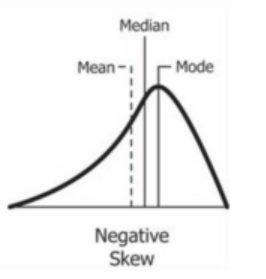
demand characteristics
participants are not passive in experiemtns, they may try to make sense of what is happening
so participant behaviour is no longer authentic
non- participant observations and evaluation
observer is not interacting with people during the observation
maintains objective psychological distance so less chance of going native
too removed from people and behaviour they are studying so less valuable insight
mode, measure of central tendency and evaluation
most frequently occuring value in a data set (2 modes is bimodal)
quick and easy to calculate
less sensitive- does not take into account all data so is less representative, being bimodal is unhelpful
participant observations and evaluation
observer is interacting with people during the observation
can experience situation as Ps do, which increase insight as they get into lives studied which increases validity
‘going native’ - line between participants and you is blurred meaning study loses objectivity
covert observation and evaluation
participants behaviour is watched and recorded without their knowledge or consent, to be ethical this must be happening naturally
no problem of demand characteristics as all behaviour is natural making data more valid
questionable ethics- people do not want behaviour noted down and studied
operationalising
making a variable able to be measured and defined
overt observations and evaluation
participant’s behaviour is watched and recorded with their knowledge and consent
more ethically acceptable as will have given informed consent
participants know they are being observed which may influence their behaviour and make it less valid
controlled observations and evaluation
usually in a lab setting where you want to control aspect of situation
extraneous variables less of an issue so replication is easier
cannot be readily applied to real life settings
using emotive language
portrays researcher’s attitudes too much so needs to be neutral
naturalistic observation? and evaluation
natural environment where target behaviour would normally occur
high external validity as can be generalised
lack of control over research so hard to replicate. uncontrolled extraneous variables means it is harder to judge behaviors
overuse of jargon
too many techincal terms that are only familiar to those in specialist field- means Ps are cut off from understanding
bell-shaped curve
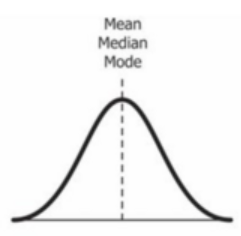
positive skew
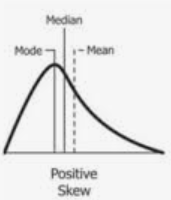
line graph
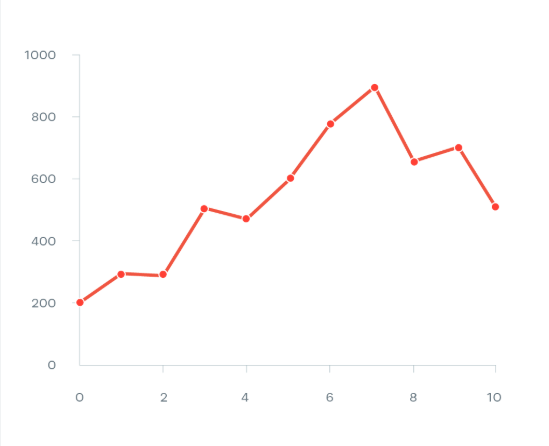
histogram
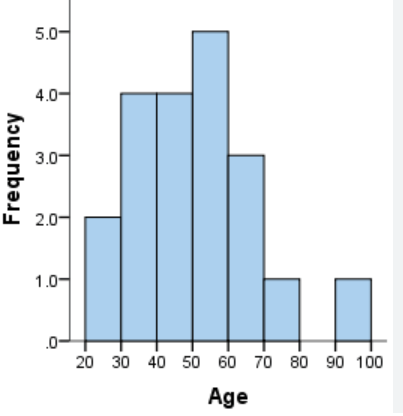
bar chart

unstructured observations and evaluation
observe all behaviour with no real system
depth of detail covered as produces rich data
only for small scale observations with few people, greater risk of observer bias as no objective behavioural categories- may only record behaviours that catch their eye. qualitative so hard to analyse
cost-benefit analysis
whether research proposals are ethically accessible
weigh up costs and benefits
may be ethically challenging but could make groundbreaking research that helps others
range, measure of dispersion
highest value- lowest value +1
structured observation and evaluation
only observe behaviour you are interested in
use behavioural categories
use sampling techniques e.g. event, time, continuous
operationalise target behaviours e.g. affection= kissing, holding hands
important that behaviours are specific so avoids individual interpretation
easier to analyse and compare data observed
5 ethical issues
deception- cannot be lied to or misled about study aims
midly perimitted if it stops demand characteristics
majorly if it benefits research
protection from harm- both physical and psychological e.g. injury, stress, embarassment
need debriefing to show true aims which always says behaviour was typical and can be offered counselling
privacy- need to be able to control information about themselves
can only make observations about people in public
data has to be stored correctly
confidentiality- anonymous, personal details not accessible
under data protection act
data not shared with other researchers
informed consent- must be told nature and purpose of study and their role in it
have right to withdraw
under 16: parent signs for them
presumptive: similar group asked if study is acceptable
prior general consent: give permission for several studies where one will involve deception
retrospective: asked after study in debriefing
independent groups, experimental designs, and evaluation
participants allocated to different groups which represent one condition
random allocated: done in an unbiased way to make sure each participant has same chance of being in each group to control order effects
no practice effect as each participant only does each condition once
each group may differ on participant variables e.g. gender, age, ethnicity
more participants needed to get the same amount of comparisons
repeated measures, experimental designs and evaluation
all participants take part in both conditions of experiment
counter balancing- attempt to control order effects so half do AB and half BA
no issue with participant variables as only compared to themseves
few participants needed so cheaper and easier
order effects- bored or get practice
higher risk of demand characteristics as easier to work out aim
matched pairs, experimental designs and evaluation
pairs of participants matched in terms of relevant variables then one member does A and one B
deals with order effects and demand characteristics
matching variables reduces problems of participant variables
expensive for little gain
takes time to match and never exact
labaratory experiments and evaluation
highly controlled environment, maniuplate independent variable and see effect on dependent variable
can infer cause and effect as highly controlled
easily replicable so more valid
demand characteristics
lack generalisability due to artificial environment and low external valdiity as does not reflect daily life
field experiment and evaluation
natural every day setting, manipulate independent variable and record effect on dependent variable
natural environment means more natural behaviour so higher validity
do not know they are being studied so no demand characteristics
loss of control over extraneous variables
harder to replicate
ethical issues due to a lack of consent
natural experiment
pre-existing independent variable and examine effect on dependent variable e.g. covid
chance to research things we could not usually
high external validity as on real world issues
limited chance to study as event is rare
participants are not randomly allocated so might be confounding variable
actual study done in a lab so may be demand characteristics
quasi experiment
independent variable based on permanent difference e.g. gender
done in a controlled environment so easily replicable which increases validity
participants are not randomly allocated as permanent previous difference so may be confounding variables
independent variable is not deliberately changed so do not know it caused observed change
questionnaires, self report techniques and evaluation
asking people about attitudes or behaviours from pre-set list of questions, either open or closed
open question- researcher does not restrict how you answer the question
closed question- researcher decides a range of possible answers
face to face, online or post
fast and cheap as multiple participants can do them at once and no need for lots of materials- even the researcher does not have to be there. means bigger samples can be gathered so more representative.
used to gain qualitative and quantitative data whoch are rich and indepth, and easy to analyse and spot trends
may be ignored leading to a lack of participants
misinterpreted and not understand question
participants may not tell truth as impacted by social desirability bias: want to look good so lie so less valid
structured interviews, self-report techniques and evaluation
1-1 conversation between researcher and participant
online or over the phone
pre determined questions and wait for response
easy to replicate as standardised
interviewer needs less training
cannot elaborate further
unstructured interviews, self-report techniques and evaluation
1-1 conversation between researcher and participant
online or over the phone
only topic of interview decided in advance then participants expand and elaborate
greater flexibility as points can be followed up to gain insight
build rapport and use empathy
risk of intervewer bias
have to sift though answers to find relevant information
semi structured interviews
mixture of structured and unstructured as the questions are decided in advance but the interviewers can ask follow up questions
random sampling and evaluation
each member has equal chance of being selected
no bias
extraneous variables should be equally divided enhancing internal validity as you know only the indendent variables had an effect
time and effort
may not be willing
could be unrepresentative
systematic sampling and evaluation
every nth person chosen from a list
avoids researcher bias
may coincidentally still be biased
opportunity sampling and evaluation
whoever is available at the time
easy quick and cheap
unrepresentative as drawn from one place so cannot be generalised
researcher bias as they control selection
volunteer sampling and evaluation
participants self select
easy and quick
want to take part so more engaged
volunteer bias- attracts certain demographic so less generalisable
stratified sampling and evaluation
target population are made into strata and proportionally chosen for sample
most representative as all subgroups represented in proportion
long process and may not want to take part
strata cannot reflect all ways people differ
meta analysis and evaluation
uses secondary data through a number of studies which investigate the same aims
these results can be pooled together to make a joint conclusion
can use statistical anlsysis to calculate and effect size which is the overall relationship across a number of studies
creates a larger, more varied sample meaning you can generalise results which increases validity
may be prone to publication bias “file drawer problem”- the researcher may not select all relevant studies and choose to leave out the studies with negative or non-significant results so the meta analysis may only represent some of the relevant data.
peer review: aims and issues
before a piece of research can become part of a journal all aspects must be objectively scrutinised by a small group of usually 2-3 specialists in the field (anonymous to researcher) to ensure publicated research is of high quality
allocate research funding- whether to award funding for a proposed research project
validate quality and relevance of research- all elemts assessed for quality and accuracy
suggest amendments and improvements- may suggest minor revisions of the work
in extreme situations conclude the work is inappropriate and should be withdrawn
anonymity- some use anonymity to criticse the writer (may be rival) as can get away with it and may be in direct compeititon for research funding
publication bias- tendency to publish significant headline grabbing findings to increase the credibility of their publication. also a preference to publish good and positve results- research which is not tends to be ignored.
burying opposing research- may suppress opposition to mainstream theories as want to maintain the status quo. researchers tend to be critical of research that contradicts their own view which slows down the rate of change.
implications for the economy
psychological research can help to influence, affect, benefit or devalue our economic prosperity
E.G.
attachment role of the father- both parents are equally capable of providing emotional support needed for development meaning parent’s working arragements can be more flexibile to maximise their income and contribute more to the economy e.g. mum as breadwinner okay, share roles more
treatment of mental health problems
absence from work due to mental health costs £5 billion annually
research can help support/ treat sufferers so they can return to work which helps the economy
sign test
nominal
difference
repeated measures
calculate difference between each category
count number of + and - (ignore any with scores of 0)
select smallest number= calculated value
check number of participants (N)- ingore any with scores of 0
check kind of hypothesis: directional (one tailed) or non directional (two tailed)
refer to critical values table- use kind of hypothesis, significance level (0.05 unless told otherwise) and N which gives critical value
calculated value must be equal or less than critical value to be significant
cannot find statistical certainties, this suggests not this proves
statistical testing
level of measurement
ordinal: data in order and subjective so unequal intervals e.g. rating scale
nominal: categories of data (discrete) so only appears once e.g. amount of girls in y12 compared to y13
interval: scale of equal size e.g. temperature (so most scientific)
- ratio level data: has a true 0 e.g. time, weight
difference or correlation
experimental design
matched pairs
repeated measures
independent groups
inferential- makes inferences and predictions about wider population based on a sample
done to see if difference is significant or just chance and whether the hypothesis should be rejected or accepted
choosing hypothesis
we always write both an alternative (directional or non directional) and null hypothesis
it if it significant we reject the null
if it not significant we accept the null
always a risk that a significant result did happen due to chance. usually 0.05/5% but may choose 0.01/1% if there is human costs e.g. drug trial
type 1 error
rejecting null when we should have accepted it
false positive
not actually significant
significant level too high e.g. 0.1/10%
type 2 error
accepting null when it should have been rejected
false negative
is actually significant
too low level e.g. 0.01/1%
statistical table
carrots should come/ mashed with swede/ under roast potaoes
Level of measurement | Test of difference | Test of correlation | |
Independent groups | Repeated measures or matched pairs | ||
Nominal | Chi-square | Sign test | Chi-square |
Ordinal | Mann- Whitney U test | Wilcoxon matched pairs signed rank test | Spearman’s rank order correlation coefficient |
Interval or Ratio | Unrelated t-test | Related t-test | Pearson’s r |
choosing parametric
date must be interval
drawn from population expected to show normal distribution
set of scores need to have dispersions in each condition
content analysis
indirect observation of secondary data in order to summarise communication and draw overall conclusions.
coding: review data and decide on behavioural categories (words, phrases, behaviours that appear more than once)
each behavioural category is counted in tally chart and displayed in bar chart
thematic analysis
once the data has been coded (themes that are broader than the categories and descriptive) may emerge show recurring ideas and meaning in material.
evaluating content and thematic analysis
ethical as material to study may already in public domain e.g. tv adverts, films as no issue with obtaining consent.
flexible method to produce both quantitative and qualitative data so can be adapted to aims of research. also cheap and easy to do.
researcher may attribute themes or motivations to the speaker that were not intended which reduces the validity of the conclusions drawn.
reflexivity: personal viewpoints seen as important part of data collected
limited by availability of methods.
reliability and types
how consistent the findings are from an investigation
internal: within itself
external: how much the measure of x varies when the test is replicated
3 ways to assess reliability
test retest- give the same test to the same P on different occasions
interobserver reliability- 2 different observers each watch the material being studied using the same behavioural categories. record the tallies separately
split half- take ½ the items, then the other ½ give them to the same P separately and compare.
correlate- it ain’t great unless it’s 0.8
improving reliability
questionnaires
interviews
experiments
observations
questionnaires- check ambiguity of questions, rewrite, replace open with closed (so less room for interpretation)
interviews- structured with the same trained interviewer
experiments- lab with high control and standardised procedures
observations- operationalised behavior categories which are clear, specific and do not overlap
validity and types
whether a method produces a legitimate response
internal: does it measure what it is meant to
external: generalised beyond the settings
- ecological: real world
- temporal: over time
- population: wider (or is sample biased)
threats to validity
demand characteristics e.g. just playing along
extraneous variables affect the DV
researcher bias/ investigator effect: expectations have an influence
weak behaviour categories leave too much room for interpretation
assessing validity
face
concurrent
face: checking on the face of it if it is measuring what it is supposed to
concurrent: comparing results to a well established test
improving the validity
questionnaires
experiments
observations
qualitative + case studies
questionnaires- lie scale to control effects of social desirability bias, Ps are anonymous
experiments- control group, tape record the instructions, double blind, standardised procedures
observations- covert, specific categories
qualitative + case studies- use triangulation, and direct quotes